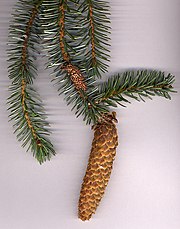Picea sitchensis
| Sitka Spruce | ||||||||||||||
|---|---|---|---|---|---|---|---|---|---|---|---|---|---|---|
 Sitka Spruce 50-55 m tall in a forestry plantation in Britain | ||||||||||||||
| Conservation status | ||||||||||||||
| Scientific classification | ||||||||||||||
| ||||||||||||||
| Binomial name | ||||||||||||||
| Picea sitchensis (Bong.) Carr. |
The Sitka Spruce (Picea sitchensis) is a large coniferous evergreen tree growing to 50-70 m tall, exceptionally to 90 m tall, and with a trunk diameter of up to 5 m. It is by far the largest species of spruce, and the third tallest conifer species in the world (after Coast Redwood and Coast Douglas-fir). It acquires its name from the community of Sitka, Alaska.
The bark is thin and scaly, flaking off in small circular plates 5-20 cm across. The crown is broad conic in young trees, becoming cylindric in older trees; old trees may have no branches in the lowest 30-40 m. The shoots are very pale buff-brown, almost white, and glabrous (hairless) but with prominent pulvini. The leaves are stiff, sharp and needle-like, 15-25 mm long, flattened in cross-section, dark glaucous blue-green above with two or three thin lines of stomata, and blue-white below with two dense bands of stomata.
The cones are pendulous, slender cylindrical, 5-11 cm long and 2 cm broad when closed, opening to 3 cm broad. They have thin, flexible scales 15-20 mm long; the bracts just above the scales are the longest of any spruce, occasionally just exserted and visible on the closed cones. They are green or reddish, maturing pale brown 5-7 months after pollination. The seeds are black, 3 mm long, with a slender, 7-9 mm long pale brown wing.
Sitka Spruce is native to the west coast of North America, with its northwestern limit on Kodiak Island, Alaska, and its southeastern limit near Fort Bragg in northern California (Griffin & Critchfield 1972). It is closely associated with the temperate rain forests and is found within a few kilometers of the coast in the southern portion of its range. North of Oregon, its range extends inland along river floodplains, but nowhere does its range extend more than 80 km from the Pacific Ocean and its inlets.
More than a century of logging has left only a remnant of the spruce forest. The largest trees were cut long before careful measurements could be made. Trees over 90 m tall may still be seen in the Pacific Rim National Park on Vancouver Island, British Columbia (the Carmanah Giant, at 96 meters (315 ft) tall the tallest tree in Canada), and in the Olympic National Park, Washington and Prairie Creek Redwoods State Park, California (USA); two at the last site are just over 96 meters (315 ft) tall. The Queets Spruce is the largest in the world with a trunk volume of 337 m³ (11,901 cubic feet). It is located near the Queets River in Olympic National Park, about 16 miles (26 km) from the Pacific Ocean. The fourth-largest tree, known as the Seaside Spruce or the Klootchy Creek Giant, with a height of 58.2 meters (191 ft) and a volume of 296 m³ (10,453 cubic feet) blew down on December 2, 2007 during a windstorm, reducing it to 75 feet (23 m) tall. This was not unexpected as the tree had been hit by lightning and damaged in previous storms.The Quinault Lake Spruce (pictured left) is the third largest in the world with a wood volume of 298 m³ (10,524 cubic feet). It is located near the eastern tip of Lake Quinault north of Aberdeen, Washington, about 24 miles (39 km) from the Pacific Ocean.
Sitka Spruce is a long-lived tree, with individuals over 700 years old known. Because it grows rapidly under favorable conditions, large size may not indicate exceptional age. The Queets Spruce has been estimated to be only 350 to 450 years old, but adds more than a cubic meter of wood each year (Van Pelt, 2001).
A unique specimen with golden foliage that used to grow on the Queen Charlotte Islands, known as Kiidk'yaas, is sacred to the Haida Native American people. It was illegally felled, although saplings grown from cuttings can now be found near its original site.
Uses
Sitka Spruce is of major importance in forestry for timber and paper production. It is used widely in piano, harp, violin, and guitar manufacture, as its high strength-to-weight ratio and regular, knot-free rings make it an excellent conductor of sound. The Steinway & Sons piano company is well known for using exclusively Sitka Spruce soundboards in its pianos. The harp company, Lyon & Healy, is well known for it use of Sitka Spruce for the soundboard of their harps as well. For these reasons, the wood is an important material for sailing boat spars, homebuilt aircraft, and the nosecones of Trident missiles.
Outside of its native range, it is particularly valued for its fast growth on poor soils and exposed sites where few other trees can be grown successfully; in ideal conditions young trees may grow 1.5 m per year. It is naturalized in some parts of Ireland and Great Britain where it was introduced in 1831 (Mitchell, 1978) and New Zealand, though not so extensively as to be considered invasive. Sitka Spruce is also planted extensively in Denmark, Norway and Iceland.[citation needed] In Norway sitka spruce was introduced in the early 1900s. It has mainly been planted along the coast from Vest-Agder in the south to Troms in the north. It is more tolerant to wind and saline ocean air, and grows faster than the native Norwegian Spruce. It is estimated that 500 000 decare in Norway are planted with sitka spruce.
Newly grown tips of Sitka Spruce branches are used to flavour spruce beer and are boiled to make syrup.
The root bark of Sitka Spruce trees is used in Native Alaskan basket-weaving designs.





No comments:
Post a Comment